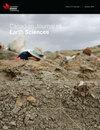Equilibration Depth and Temperature of Neogene Alkaline Lavas in the Cordillera of Alaska and Canada as a Constraint on the Lithosphere-Asthenosphere Boundary
IF 1.6
4区 地球科学
Q3 GEOSCIENCES, MULTIDISCIPLINARY
引用次数: 1
Abstract
We have estimated the geochemical equilibration depth and temperature of the widespread Neogene alkaline basalts in the Cordillera of Alaska, NW Canada and in Mexico using geobarometry on bulk compositions that have been minimally differentiated in upward transit. The method has uncertainties of about ±10 km and < 70 oC. The regional averages of geochemical equilibration depth for 12 sites in Alaska vary from 50±10 to 84±2 km, somewhat broader than those from the Cordillera of western Canada, western USA, and Mexico. There are no associations of depth with terranes or geological provinces. The final equilibration depth of lavas with the surrounding mantle is concluded to be where partial melt percolating from greater depths ponds at the lithosphere-asthenosphere boundary (LAB) until it becomes gravitationally unstable and moves upward in conduits. The top of the low velocity zone from seismic receiver functions, taken to be the LAB in regions of Alaska where Neogene volcanism occurs, varies from 60 - 85 km, covering the range of geochemical equilibration depths of the alkaline lavas. A mean lava equilibration depth of 65 ±10 km occurs in 24 of 36 alkaline volcanic centers from Alaska to Mexico, and several other global locations, suggesting the LAB may be controlled to a first order by the change in H2O storage capacity and viscosity across the garnet-spinel peridotite phase change at this depth. The scatter and variation in equilibration depths and temperatures are a factor of two greater than the recognized uncertainties, and are not yet explained.阿拉斯加和加拿大科迪勒拉新近纪碱性熔岩平衡深度和温度对岩石圈-软流圈边界的约束
我们利用地球气压法对在向上运输过程中分化最小的大块成分进行了地球化学平衡深度和温度的估算。该方法的不确定度约为±10 km,温度< 70℃。阿拉斯加12个测点地球化学平衡深度的区域平均值在50±10 ~ 84±2 km之间,比加拿大西部、美国西部和墨西哥的科迪勒拉地区略宽。没有将深度与地形或地质省联系起来。熔岩与周围地幔的最终平衡深度是部分熔体从较深的岩石圈-软流圈边界(LAB)渗透,直到它变得重力不稳定并在管道中向上移动。在阿拉斯加新近纪火山活动发生的地区,地震接收函数的低速带顶部被认为是LAB,范围从60 - 85 km不等,覆盖了碱性熔岩的地球化学平衡深度范围。从阿拉斯加到墨西哥的36个碱性火山中心中,有24个火山中心的平均熔岩平衡深度为65±10 km,以及全球其他几个地区,这表明在该深度,石榴石尖晶石橄榄岩相变过程中H2O储存容量和粘度的变化可能是控制熔岩平衡的一级因素。平衡深度和温度的分散和变化是比公认的不确定度大两倍的因素,而且还没有得到解释。
本文章由计算机程序翻译,如有差异,请以英文原文为准。
求助全文
约1分钟内获得全文
求助全文
来源期刊

Canadian Journal of Earth Sciences
地学-地球科学综合
CiteScore
2.80
自引率
7.10%
发文量
66
审稿时长
6-12 weeks
期刊介绍:
The Canadian Journal of Earth Sciences reports current research in climate and environmental geoscience; geoarchaeology and forensic geoscience; geochronology and geochemistry; geophysics; GIS and geomatics; hydrology; mineralogy and petrology; mining and engineering geology; ore deposits and economic geology; paleontology, petroleum geology and basin analysis; physical geography and Quaternary geoscience; planetary geoscience; sedimentology and stratigraphy; soil sciences; and structural geology and tectonics. It also publishes special issues that focus on information and studies about a particular segment of earth sciences.
 求助内容:
求助内容: 应助结果提醒方式:
应助结果提醒方式:


